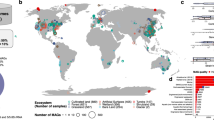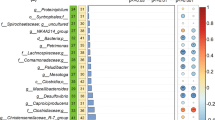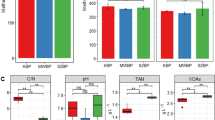Abstract
Microorganisms can produce renewable energy in large quantities and without damaging the environment or disrupting food supply. The microbial communities must be robust and self-stabilizing, and their essential syntrophies must be managed. Pre-genomic, genomic and post-genomic tools can provide crucial information about the structure and function of these microbial communities. Applying these tools will help accelerate the rate at which microbial bioenergy processes move from intriguing science to real-world practice.
This is a preview of subscription content, access via your institution
Access options
Subscribe to this journal
Receive 12 print issues and online access
$209.00 per year
only $17.42 per issue
Buy this article
- Purchase on Springer Link
- Instant access to full article PDF
Prices may be subject to local taxes which are calculated during checkout



Similar content being viewed by others
References
Energy Information Administration. Annual energy outlook 2006 with projections to 2030 [online] (2006).
Chynoweth, D. P., Owens, J. M. & Legrand, R. Renewable methane from anaerobic digestion of biomass. Renew. Energy 22, 1–8 (2001).
Hall, D. O. & Rosillo-Calle, F. in Survey of Energy Resources 18th Edn 227–241 (World Energy Council, London, 1998).
Logan, B. E. Extracting hydrogen and electricity from renewable resources. Environ. Sci. Technol. 38, 160A–167A (2004).
Rittmann, B. E. Opportunities for renewable bioenergy using microorganisms. Biotechnol. Bioeng. 100, 203–212 (2008).
Rittmann, B. E., Torres, C. I. & Kato-Marcus, A. in Emerging Technologies (ed. Shah, V.) (Springer, New York, in the press).
Chisti, Y. Biodiesel from microalgae. Biotechnol. Adv. 25, 294–306 (2007).
Pulz, O. Photobioreactors: production systems for phototrophic microorganisms. Appl. Microbiol. Biotechnol. 57, 287–293 (2001).
Huber, G. W., Iborra, S. & Corma, A. Synthesis of transportation fuels from biomass: chemistry, catalysts, and engineering. Chem. Rev. 106, 4044–4098 (2006).
Cho, Y. K. et al. Development of a solar-powered microbial fuel cell. J. Appl. Microbiol. 104, 640–650 (2008).
Rittmann, B. E. & McCarty, P. L. Environmental Biotechnology: Principles and Applications (McGraw–Hill, New York, 2001).
Tchobanoglous, G. & Burton, F. L. Wastewater Engineering: Treatment and Reuse (McGraw–Hill, New York, 1991).
Gieg, L. M., Duncan, K. E. & Suflita, J. M. Bioenergy production via microbial conversion of residual oil to natural gas. Appl. Environ. Microbiol. 74, 3022–3029 (2008).
Lindorfer, H., Waltenberger, R., Kollner, K., Braun, R. & Kirchmayr, R. New data on temperature optimum and temperature changes in energy crop digesters. Bioresour. Technol. 99, 7011–7019 (2008).
Logan, B. E. & Regan, J. M. Electricity-producing bacterial communities in microbial fuel cells. Trends Microbiol. 14, 512–518 (2006).
Parkin, G. F. & Owen, W. F. Fundamentals of anaerobic digestion of wastewater sludges. J. Environ. Engin. 112, 867–920 (1986).
Hallenbeck, P. C. Fundamentals of the fermentative production of hydrogen. Water Sci. Technol. 52, 21–29 (2005).
Lee, H. S., Parameswaran, P., Kato Marcus, A., Torres, C. I. & Rittmann, B. E. Evaluation of energy-conversion efficiencies in microbial fuel cells (MFCs) utilizing fermentable and non-fermentable substrates. Water Res. 42, 1501–1510 (2008).
Lovley, D. R. Bug juice: harvesting electricity with microorganisms. Nature Rev. Microbiol. 4, 497–508 (2006).
Bond, D. R., Holmes, D. E., Tender, L. M. & Lovley, D. R. Electrode-reducing microorganisms that harvest energy from marine sediments. Science 295, 483–485 (2002).
Schink, B. Energetics of syntrophic cooperation in methanogenic degradation. Microbiol. Mol. Biol. Rev. 61, 262–280 (1997).
Lee, M. J. & Zinder, S. H. Hydrogen partial pressures in a thermophilic acetate-oxidizing methanogenic coculture. Appl. Environ. Microbiol. 54, 1457–1461 (1988).
Nath, K. & Das, D. Improvement of fermentative hydrogen production: various approaches. Appl. Microbiol. Biotechnol. 65, 520–529 (2004).
Fang, H. H. P., Zhang, T. & Li, C. L. Characterization of Fe-hydrogenase genes diversity and hydrogen-producing population in an acidophilic sludge. J. Biotechnol. 126, 357–364 (2006).
Gorby, Y. A. et al. Electrically conductive bacterial nanowires produced by Shewanella oneidensis strain MR-1 and other microorganisms. Proc. Natl Acad. Sci. USA 103, 11358–11363 (2006).
Reguera, G. et al. Extracellular electron transfer via microbial nanowires. Nature 435, 1098–1101 (2005).
Reguera, G. et al. Biofilm and nanowire production leads to increased current in Geobacter sulfurreducens fuel cells. Appl. Environ. Microbiol. 72, 7345–7348 (2006).
Laspidou, C. S. & Rittmann, B. E. Non-steady state modeling of extracellular polymeric substances, soluble microbial products, and active and inert biomass. Water Res. 36, 1983–1992 (2002).
Laspidou, C. S. & Rittmann, B. E. A unified theory for extracellular polymeric substances, soluble microbial products, and active and inert biomass. Water Res. 36, 2711–2720 (2002).
Miura, Y., Watanabe, Y. & Okabe, S. Significance of chloroflexi in performance of submerged membrane bioreactors (MBR) treating municipal wastewater. Environ. Sci. Technol. 41, 7787–7794 (2007).
Kaneko, T. et al. Sequence analysis of the genome of the unicellular cyanobacterium Synechocystis sp. strain PCC6803. I. Sequence features in the 1 Mb region from map positions 64% to 92% of the genome. DNA Res. 2, 153–166 (1995).
Bult, C. J. et al. Complete genome sequence of the methanogenic archaeon, Methanococcus jannaschii. Science 273, 1058–1073 (1996).
Hung, C.-H. et al. Quantitative analysis of a high-rate hydrogen-producing microbial community in anaerobic agitated granular sludge bed bioreactors using glucose as substrate. Appl. Microbiol. Biotechnol. 75, 693–701 (2007).
Jo, J. H., Jeon, C. O., Lee, D. S. & Park, J. M. Process stability and microbial community structure in anaerobic hydrogen-producing microflora from food waste containing kimchi. J. Biotechnol. 131, 300–308 (2007).
Kim, S.-H., Han, S.-K. & Shin, H.-S. Effect of substrate concentration on hydrogen production and 16S rDNA-based analysis of the microbial community in a continuous fermenter. Process Biochem. 41, 199–207 (2006).
Wang, X., Hoefel, D., Saint, C. P., Monis, P. T. & Jin, B. The isolation and microbial community analysis of hydrogen producing bacteria from activated sludge. J. Appl. Microbiol. 103, 1415–1423 (2007).
Collins, G., Woods, A., McHugh, S., Carton, M. W. & O'Flaherty, V. Microbial community structure and methanogenic activity during start-up of psychrophilic anaerobic digesters treating synthetic industrial wastewaters. FEMS Microbiol. Ecol. 46, 159–170 (2003).
Liu, W. T., Chan, O. C. & Fang, H. H. P. Microbial community dynamics during start-up of acidogenic anaerobic reactors. Water Res. 36, 3203–3210 (2002).
Sekiguchi, Y., Kamagata, Y., Nakamura, K., Ohashi, A. & Harada, H. Fluorescence in situ hybridization using 16S rRNA-targeted oligonucleotides reveals localization of methanogens and selected uncultured bacteria in mesophilic and thermophilic sludge granules. Appl. Environ. Microbiol. 65, 1280–1288 (1999).
Xing, D. F., Ren, N. Q. & Rittmann, B. E. Genetic diversity of hydrogen-producing bacteria in an acidophilic ethanol-H2-coproducing system, analyzed using the [Fe]-hydrogenase gene. Appl. Environ. Microbiol. 74, 1232–1239 (2008).
Holmes, D. E. et al. Microbial communities associated with electrodes harvesting electricity from a variety of aquatic sediments. Microb. Ecol. 48, 178–190 (2004).
Jung, S. & Regan, J. M. Comparison of anode bacterial communities and performance in microbial fuel cells with different electron donors. Appl. Microbiol. Biotechnol. 77, 393–402 (2007).
Tender, L. M. et al. Harnessing microbially generated power on the seafloor. Nature Biotechnol. 20, 821–825 (2002).
Choo, Y. F., Lee, J., Chang, I. S. & Kim, B. H. Bacterial communities in microbial fuel cells enriched with high concentrations of glucose and glutamate. J. Microbiol. Biotechnol. 16, 1481–1484 (2006).
Kim, J. R., Jung, S. H., Regan, J. M. & Logan, B. E. Electricity generation and microbial community analysis of alcohol powered microbial fuel cells. Bioresour. Technol. 98, 2568–2577 (2007).
Phung, N. T. et al. Analysis of microbial diversity in oligotrophic microbial fuel cells using 16S rDNA sequences. FEMS Microbiol. Lett. 233, 77–82 (2004).
Rabaey, K., Boon, N., Siciliano, S. D., Verhaege, M. & Verstraete, W. Biofuel cells select for microbial consortia that self-mediate electron transfer. Appl. Environ. Microbiol. 70, 5373–5382 (2004).
Shigematsu, T. et al. Effect of dilution rate on structure of a mesophilic acetate-degrading methanogenic community during continuous cultivation. J. Biosci. Bioeng. 96, 547–558 (2003).
Yu, Y., Lee, C. & Hwang, S. Analysis of community structures in anaerobic processes using a quantitative real-time PCR method. Water Sci. Technol. 52, 85–91 (2005).
Yu, Y., Lee, C., Kim, J. & Hwang, S. Group-specific primer and probe sets to detect methanogenic communities using quantitative real-time polymerase chain reaction. Biotechnol. Bioeng. 89, 670–679 (2005).
Ariesyady, H. D., Ito, T., Yoshiguchi, K. & Okabe, S. Phylogenetic and functional diversity of propionate-oxidizing bacteria in an anaerobic digester sludge. Appl. Microbiol. Biotechnol. 75, 673–683 (2007).
Shigematsu, T. et al. Effect of dilution rate on metabolic pathway shift between aceticlastic and nonaceticlastic methanogenesis in chemostat cultivation. Appl. Environ. Microbiol. 70, 4048–4052 (2004).
Nyren, P., Pettersson, B. & Uhlen, M. Solid-phase DNA minisequencing by an enzymatic luminometric inorganic pyrophosphate detection assay. Anal. Biochem. 208, 171–175 (1993).
Ronaghi, M., Karamohamed, S., Pettersson, B., Uhlen, M. & Nyren, P. Real-time DNA sequencing using detection of pyrophosphate release. Anal. Biochem. 242, 84–89 (1996).
Liolios, K., Mavromatis, K., Tavernarakis, N. & Kyrpides, N. C. The Genomes On Line Database (GOLD) in 2007: status of genomic and metagenomic projects and their associated metadata. Nucleic Acids Res. 36, D475–D479 (2008).
Dinsdale, E. A. et al. Functional metagenomic profiling of nine biomes. Nature 452, 629–632 (2008).
Mavromatis, K. et al. Use of simulated data sets to evaluate the fidelity of metagenomic processing methods. Nature Methods 4, 495–500 (2007).
Holmes, D. E. et al. Microarray and genetic analysis of electron transfer to electrodes in Geobacter sulfurreducens. Environ. Microbiol. 8, 1805–1815 (2006).
Mahadevan, R. et al. Characterizing regulation of metabolism in Geobacter sulfurreducens through genome-wide expression data and sequence analysis. OMICS 12, 33–59 (2008).
Methe, B. A., Webster, J., Nevin, K., Butler, J. & Lovley, D. R. DNA microarray analysis of nitrogen fixation and Fe(III) reduction in Geobacter sulfurreducens. Appl. Environ. Microbiol. 71, 2530–2538 (2005).
Mackenzie, C. et al. Postgenomic adventures with Rhodobacter sphaeroides. Annu. Rev. Microbiol. 61, 283–307 (2007).
Holmes, D. E. et al. Potential for quantifying expression of the Geobacteraceae citrate synthase gene to assess the activity of Geobacteraceae in the subsurface and on current-harvesting electrodes. Appl. Environ. Microbiol. 71, 6870–6877 (2005).
Holmes, D. E. et al. Genes for two multicopper proteins required for Fe(III) oxide reduction in Geobacter sulfurreducens have different expression patterns both in the subsurface and on energy-harvesting electrodes. Microbiology 154, 1422–1435 (2008).
Bernstein, J. A., Khodursky, A. B., Lin, P. H., Lin-Chao, S. & Cohen, S. N. Global analysis of mRNA decay and abundance in Escherichia coli at single-gene resolution using two-color fluorescent DNA microarrays. Proc. Natl Acad. Sci. USA 99, 9697–9702 (2002).
Ekman, M., Tollbäck, P. & Bergman, B. Proteomic analysis of the cyanobacterium of the Azolla symbiosis: identity, adaptation, and NifH modification. J. Exp. Bot. 59, 1023–1034 (2008).
Mandal, M. & Breaker, R. R. Gene regulation by riboswitches. Nature Rev. Mol. Cell Biol. 5, 451–463 (2004).
Mukhopadhyay, B., Johnson, E. F. & Wolfe, R. S. A novel pH2 control on the expression of flagella in the hyperthermophilic strictly hydrogenotrophic methanarchaeaon Methanococcus jannaschii. Proc. Natl Acad. Sci. USA 97, 11522–11527 (2000).
Nunez, C. et al. DNA microarray and proteomic analyses of the RpoS regulon in Geobacter sulfurreducens. J. Bacteriol. 188, 2792–2800 (2006).
Angenent, L. T., Karim, K., Al-Dahhan, M. H. & Domiguez-Espinosa, R. Production of bioenergy and biochemicals from industrial and agricultural wastewater. Trends Biotechnol. 22, 477–485 (2004).
Jin, B., van Leeuwen, J., Yu, Q. & Patel, B. Screening and selection of microfungi for microbial biomass protein production and water reclamation from starch processing wastewater. J. Chem. Technol. Biotechnol. 74, 106–110 (1999).
Halden, R. U., Colquhoun, D. R. & Wisniewski, E. S. Identification and phenotypic characterization of Sphingomonas wittichii strain RW1 by peptide mass fingerprinting using matrix-assisted laser desorption ionization-time of flight mass spectrometry. Appl. Environ. Microbiol. 71, 2442–2451 (2005).
Vavilin, D., Yao, D. & Vermaas, W. Small Cab-like proteins retard degradation of photosystem II-associated chlorophyll in Synechocystis sp. PCC 6803: kinetic analysis of pigment labeling with 15N and 13C. J. Biol. Chem. 282, 37660–37668 (2007).
Callister, S. J. et al. Application of the accurate mass and time tag approach to the proteome analysis of sub-cellular fractions obtained from Rhodobacter sphaeroides 2.4.1. Aerobic and photosynthetic cell cultures. J. Proteome Res. 5, 1940–1947 (2006).
Callister, S. J. et al. Comparison of aerobic and photosynthetic Rhodobacter sphaeroides 2.4.1 proteomes. J. Microbiol. Methods 67, 424–436 (2006).
Zhang, W. et al. A proteomic view of Desulfovibrio vulgaris metabolism as determined by liquid chromatography coupled with tandem mass spectrometry. Proteomics 6, 4286–4299 (2006).
Mahadevan, R. et al. Characterization of metabolism in the Fe(III)-reducing organism Geobacter sulfurreducens by constraint-based modeling. Appl. Environ. Microbiol. 72, 1558–1568 (2006).
Righetti, P. G. et al. Critical survey of quantitative proteomics in two-dimensional electrophoretic approaches. J. Chromatogr. A 1051, 3–17 (2004).
Unlu, M., Morgan, M. E. & Minden, J. S. Difference gel electrophoresis: a single gel method for detecting changes in protein extracts. Electrophoresis 18, 2071–2077 (1997).
Ross, P. L. et al. Multiplexed protein quantitation in Saccharomyces cerevisiae using amine-reactive isobaric tagging reagents. Mol. Cell Proteomics 3, 1154–1169 (2004).
Gygi, S. P. et al. Quantitative analysis of complex protein mixtures using isotope-coded affinity tags. Nature Biotechnol. 17, 994–999 (1999).
Gerber, S. A., Rush, J., Stemman, O., Kirschner, M. W. & Gygi, S. P. Absolute quantification of proteins and phosphoproteins from cell lysates by tandem MS. Proc. Natl Acad. Sci. USA 100, 6940–6945 (2003).
Kirkpatrick, D. S., Gerber, S. A. & Gygi, S. P. The absolute quantification strategy: a general procedure for the quantification of proteins and post-translational modifications. Methods 35, 265–273 (2005).
Rittmann, B. E. Microbial ecology to manage processes in environmental biotechnology. Trends Biotechnol. 24, 261–266 (2006).
Colquhoun, D. R. Public Health Applications of Quantitative Protein Biomarkers. Thesis, The Johns Hopkins Univ., Maryland (2008).
Acknowledgements
The authors have been supported by the National Institute of Environmental Health Sciences NIEHS (grant number 1R01ES015445), the Biodesign Institute at Arizona State University, Science Foundation Arizona, OpenCEL and NZ Legacy.
Author information
Authors and Affiliations
Corresponding author
Related links
Related links
DATABASES
Entrez Genome
Methanocaldococcus jannaschii DSM 2661
Entrez Genome Project
FURTHER INFORMATION
Joint Genome Institute (Why Sequence a Biogas-Producing Microbial Community?)
Glossary
- Carbon neutral
-
The use of carbon dioxide that was released into the atmosphere from the recent consumption of fuel which results in a short-term carbon cycle rather than the net addition of carbon dioxide to the atmosphere.
- Hydraulic retention time
-
The average time that water that is applied to the system resides in the system. The hydraulic retention time is computed as V/Q, in which V is the system volume and Q is the fluid flow rate.
- Renewable
-
In the context of energy, an ultimate source that is available indefinitely and is not depleted. Sunlight is the main renewable energy source.
- Self-stabilization
-
Natural recovery of a desired function of a microbial community following a perturbation.
- Specific growth rate
-
The growth rate of biomass (for example, grams of dry weight per day) divided by the total amount of biomass in the system (for example, grams of dry weight).
- Syntrophy
-
Two or more different types of microorganisms that combine their metabolic capabilities to catabolize a substrate that cannot be catabolized by either microorganism alone.
Rights and permissions
About this article
Cite this article
Rittmann, B., Krajmalnik-Brown, R. & Halden, R. Pre-genomic, genomic and post-genomic study of microbial communities involved in bioenergy. Nat Rev Microbiol 6, 604–612 (2008). https://doi.org/10.1038/nrmicro1939
Published:
Issue Date:
DOI: https://doi.org/10.1038/nrmicro1939
This article is cited by
-
Anodic and cathodic biofilms coupled with electricity generation in single-chamber microbial fuel cell using activated sludge
Bioprocess and Biosystems Engineering (2021)
-
Potential of cyanobacteria in the conversion of wastewater to biofuels
World Journal of Microbiology and Biotechnology (2021)
-
Microbial fuel cells: a comprehensive review for beginners
3 Biotech (2021)



